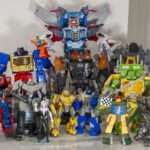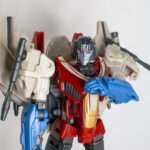Friends, readers, anyone that hasn’t heard of it, let me tell you about Kamen Rider Zero-One. A I mentioned the last time I looked at a Kamen Rider thing, this is a Japanese Tokusatsu superhero franchise, usually focused around a hero or heroes who transform into armored up bug-themed warriors, to fight rubber suit monsters. It’s been running since the 70s, and a part of its long-running appeal is that it’s a bunch of individual, mostly-unconnected shows that tell a lot of different stories, and have very different aesthetics and tones.While it’s still aimed at kids, most of these shows are a bit more serious, more serialized, and much more well-produced than your typical Power Ranger series. Zero-One came out in 2019, and was the first Rider show I watched, because the specific plot of it really appealed to me.
Zero-One is a science fiction story, about a world where androids called HumaGears live among humanity, basically as a new generation of computer-assisted help. The CEO of the company that makes them, however, has passed away, and to everyone’s surprise, his will cedes the company to his grandson, Aruto Hiden, along with a strange piece of technology, the Zero-One Driver. Aruto is, of all things, a failed stand-up comedian, and initially refuses his new role, until a moment of crisis leads him to discover the Driver’s true power: It can materialize a suit of powered armor around him, making him into Kamen Rider Zero-One. As a CEO, he now has to work to repair strained relations between humanity, and his company’s HumaGears, and as an Iron-Man-Adjacent superhero, he’s got to contend with a group of evil HumaGears trying to jumpstart a robot revolution (via Rubber Suit Monsters and Kamen Riders of their own), a human law-enforcement agency (who also have their own Kamen Riders), a shadowy billionaire manipulating affairs (ditto), and more threats (with more Riders). It’s hard to explain the appeal of the show, it’s sort of like if Blade Runner wasn’t rainy, slow, and dour, but was sunny, colorful, and upbeat, and also had kung-fu fights with Anime super attacks happening constantly. It’s also available free to watch, right here, and also right here (no, you don’t need to have watched any other Rider stuff to follow it, it’s self-contained).

His first transformation.
As befits any long-running toyetic superhero franchise, Kamen Rider has merchandise for days. Just counting figures, you’ve the smaller So-do and Sho-do minifigures (that’s what I reviewed previously), the medium-sized gimmick figures, and the high-end SH Figuarts. That last category is what I’m looking at today. Now, SH Figuarts are typically expensive, usually triple-digit prices, so it’s not a scale of figure I typically own. It’s comparable in scale and quality to the Figma Samus Aran I reviewed (and paid mad money for) previously. But in this case, I got a crazy deal from a Toronto shop called Anime City (they’re cool, check them out if you’re local), who was selling Mr. Hiden here for a mere $60 Canadian. One reason might have been that this is technically a variant of him, with translucent parts, apparently a convention exclusive that wound up fetching less demand than the standard version. Either way, I get to look at a high-end figure of the main character of the show that got me into this franchise, and so do you!
Some more housekeeping: A big part of the show’s story was that Aruto, and the other Kamen Riders, had multiple different suits of armor they could materialize around themselves, with it sort of being an arms race at times to develop more powerful ones. This figure is Aruto’s “Rising Hopper” suit, which is the one he started out with, and the one he kind of defaulted to, unless the situation required bigger guns (it’s also the one used in all the marketing).
The Sculpt
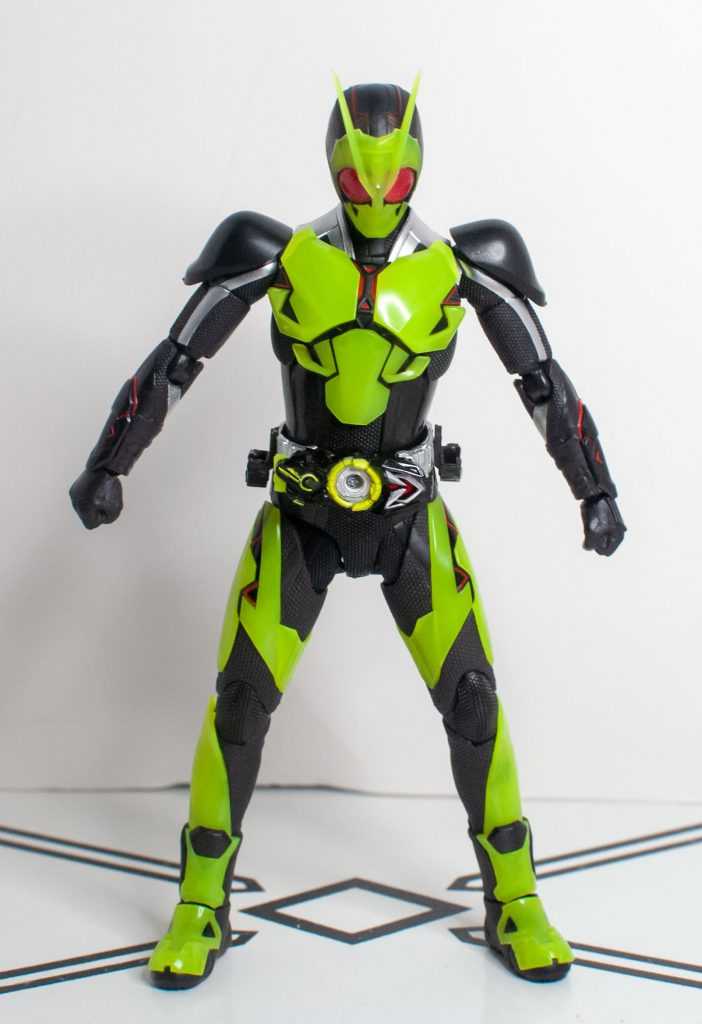
One of the few times you’ll see him trying to look serious.
At 6 inches, Zero-One’s pretty much at the standard larger action figure scale, able to pal around with Marvel Legends, Figmas, and Power Rangers Lightning Collection.
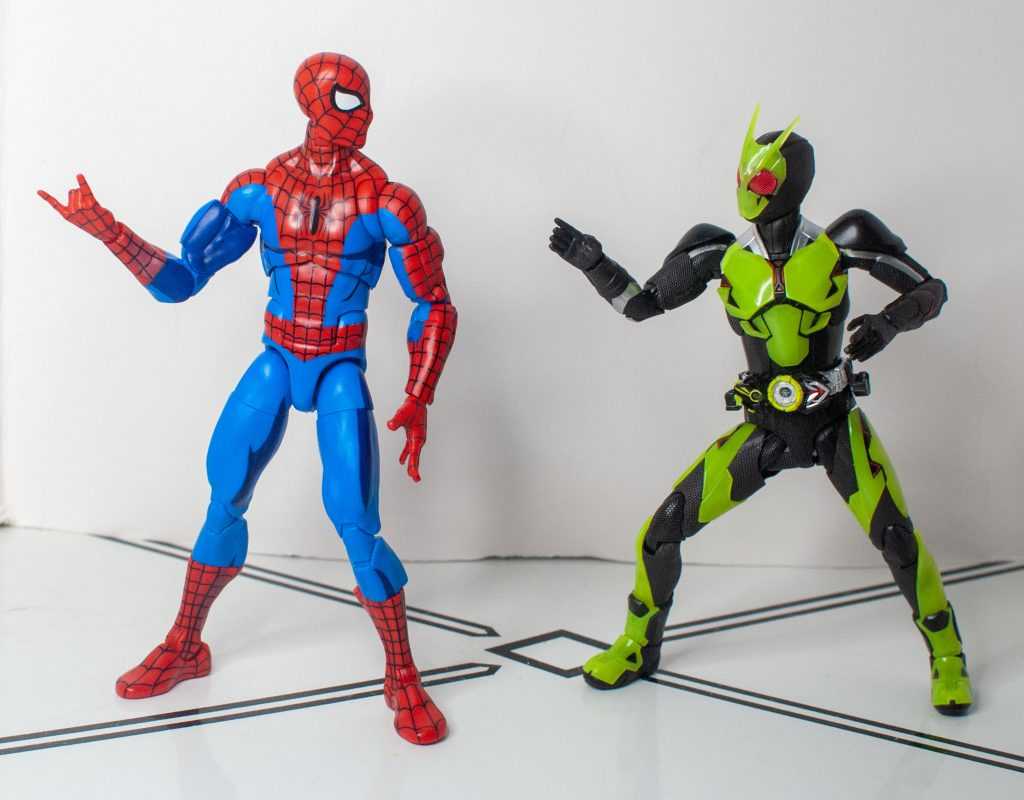
He heard there was a “Spider Man” nearby, and made some unfortunate assumptions.
In terms of the design itself, it’s a bit of fandom wisdom that if you want to figure out what Kamen Rider show to watch, you should pick one where you like the design of the main character’s suit. And this was a design that immediately appealed to me.

Attack of the bad jokes!
In a franchise where the designs of its characters can sometimes be kind of baroque, Zero-One has a clean, simplified design, one that really emphasized the “powered armor” nature of his gear. He’s a grasshopper-themed hero, one who wears a black fabric undersuit, with plates of armor layered over it. Up top, he’s got an angular, bug-like mask, with big compound eyes, and antenna. It’s hard to really explain the appeal, it’s just a good design, really dynamic, and it cuts a heroic silhouette. It’s just peak character design.
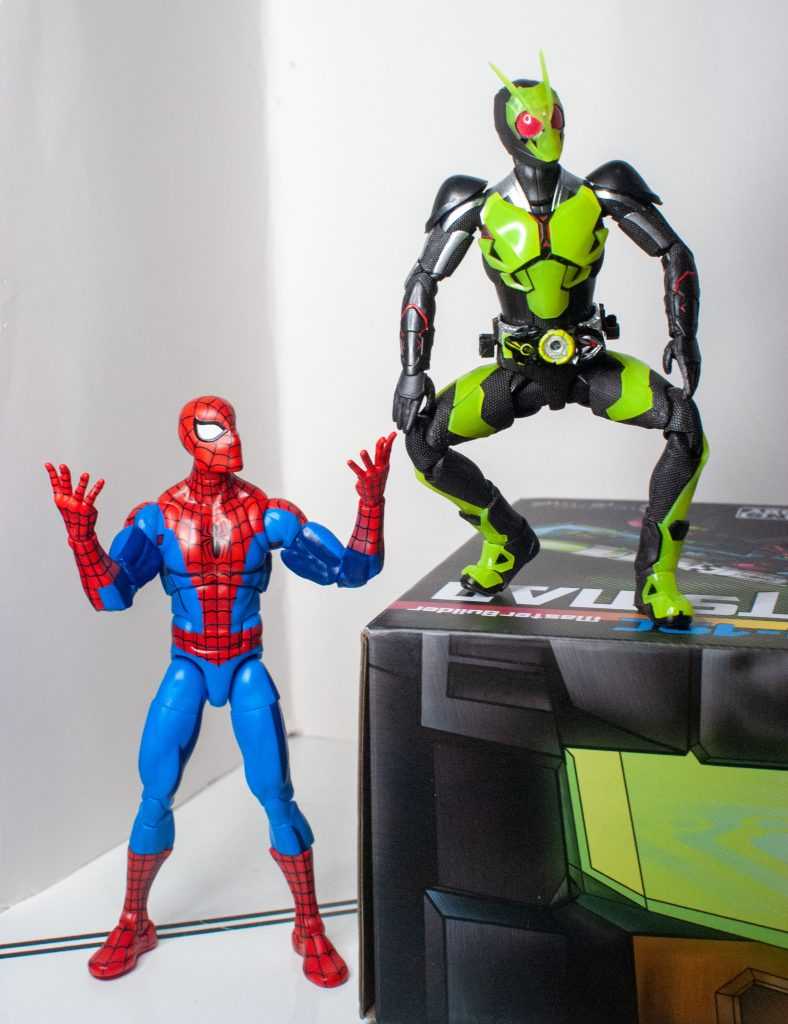
“So you’re just gonna crib my style now?”
More importantly, it’s a design rendered here with a very detailed, intricate sculpt, especially when compared to the smaller So-Do model of his I also have.
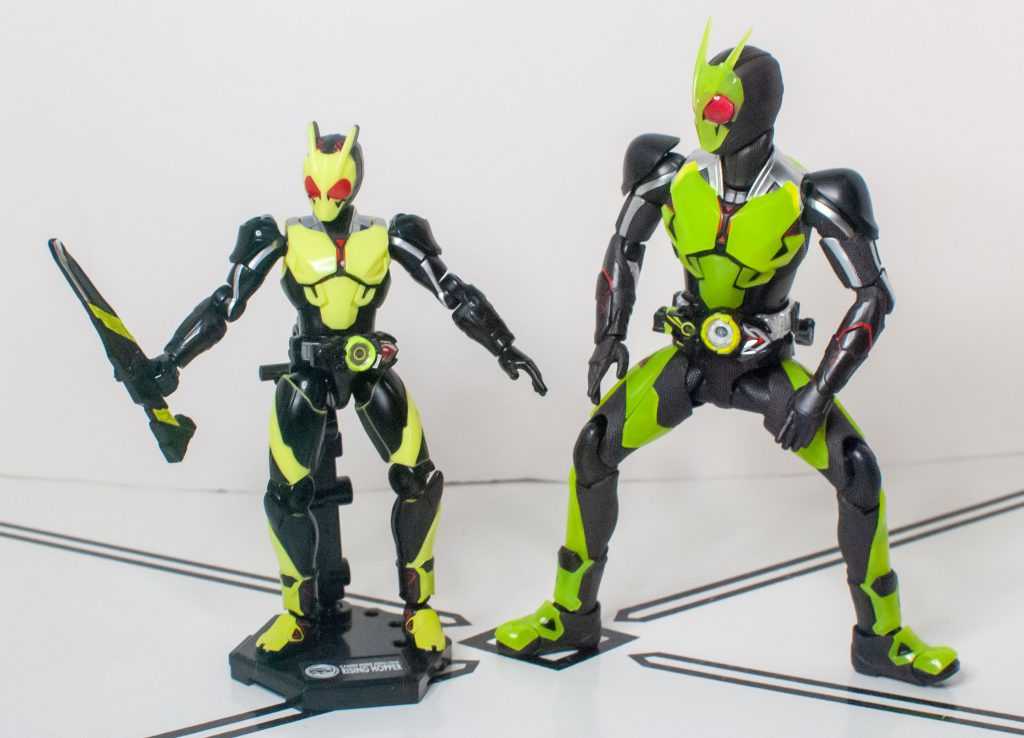
“Handsome little guy, isn’t he?”
Since this was a live-action series being produced at the exact same time as the toys, I’d presume they got direct access to the physical costume to make it as screen-accurate as they could, and it shows.
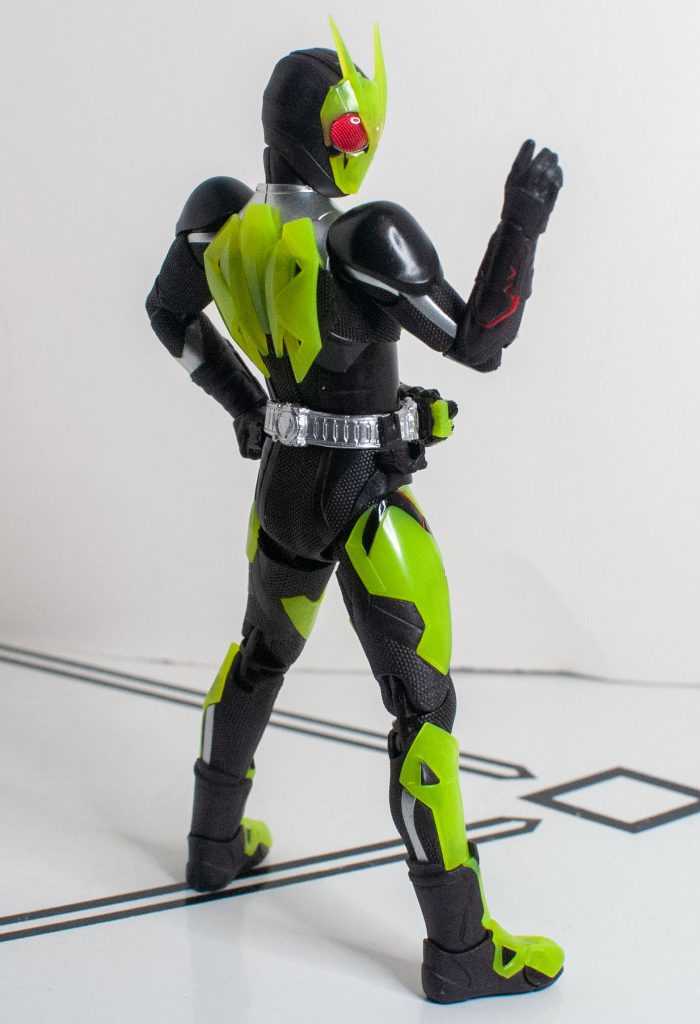
There’s a lot of detail here.
Getting in really close, you’ve got stuff like how his undersuit has the pattern of the material it was made out of sculpted on it, like a basketball (I think it was rubber?), while up top, his insect eyes have tiny compound segments sculpted inside them.
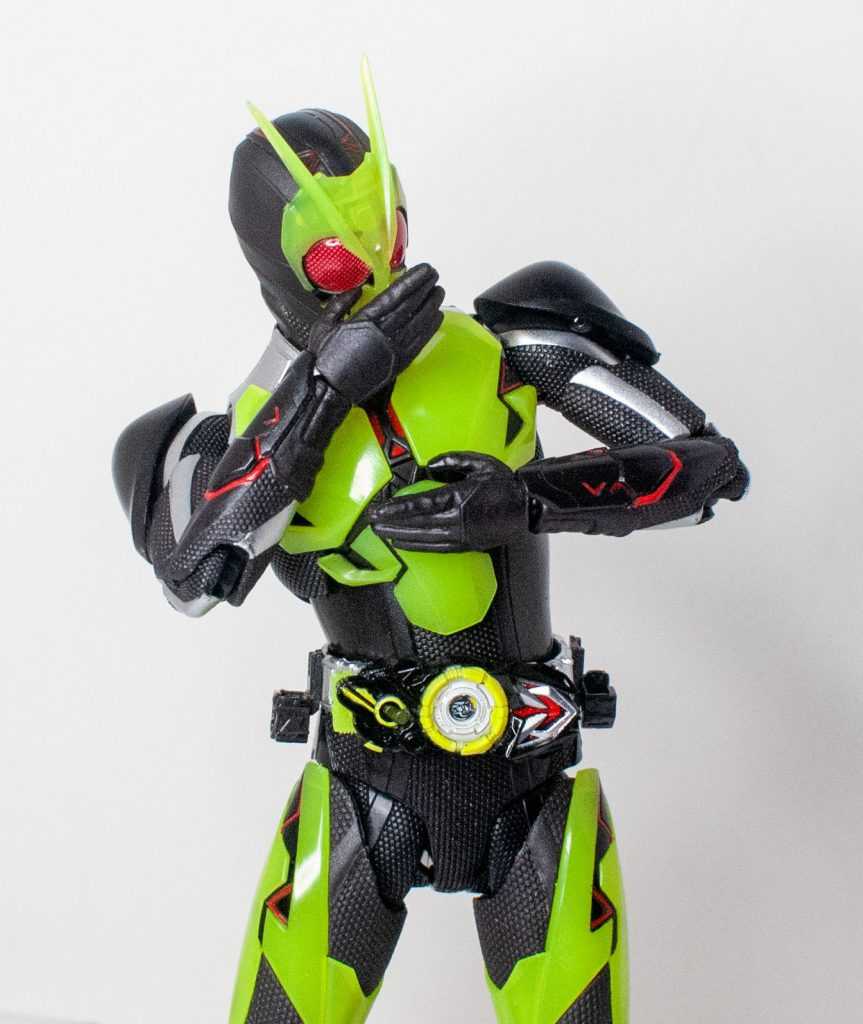
He’s startled at the things he can see.
A ton of work specifically went into the Zero One Driver on his waist, a big complicated oval device that presumably got this much attention because it also exists as a larger toy. It even has a little clear window in the middle, with a miniscule Rising Hopper logo visible through it.
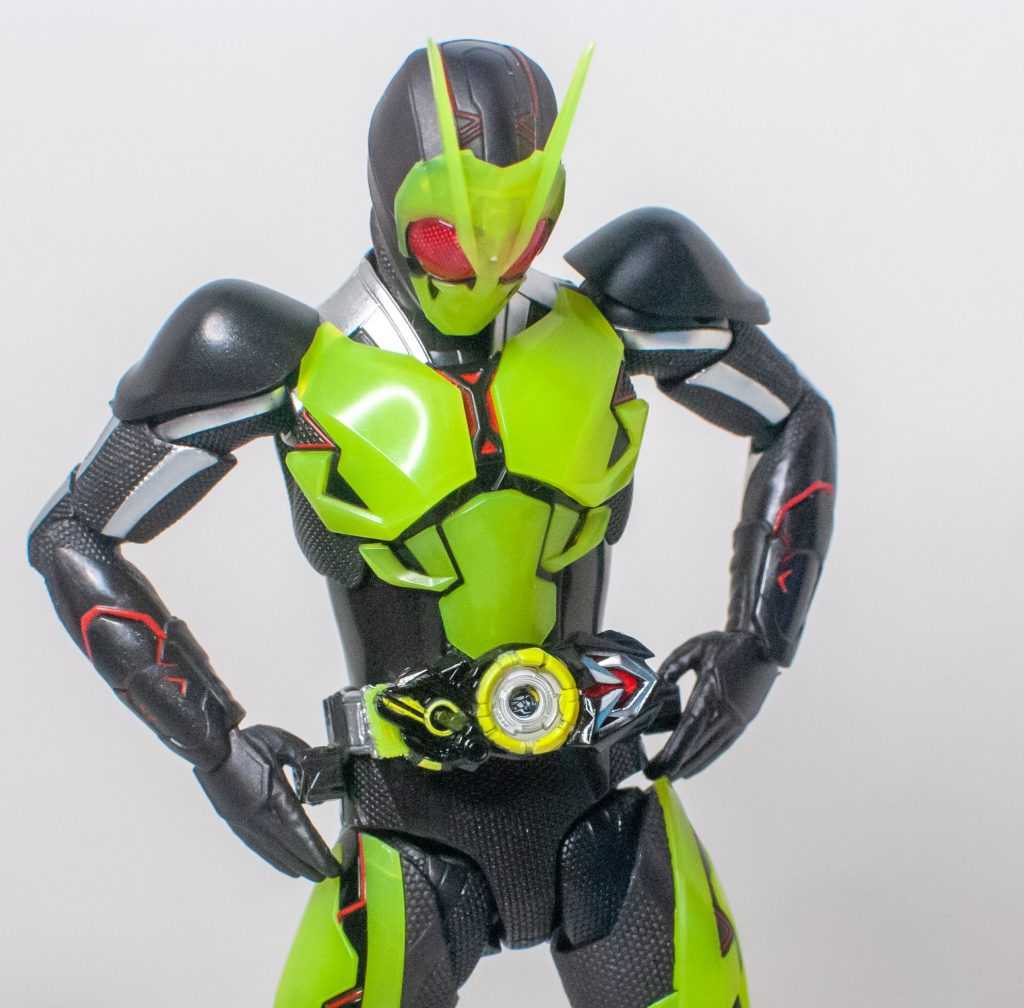
*belt voice* “It’s high fashion.”
The sculpt even does a fair job of hiding the joint cuts, and given how toyetic the franchise is, I wonder if that wasn’t in consideration when designing the original suit.
The Colors
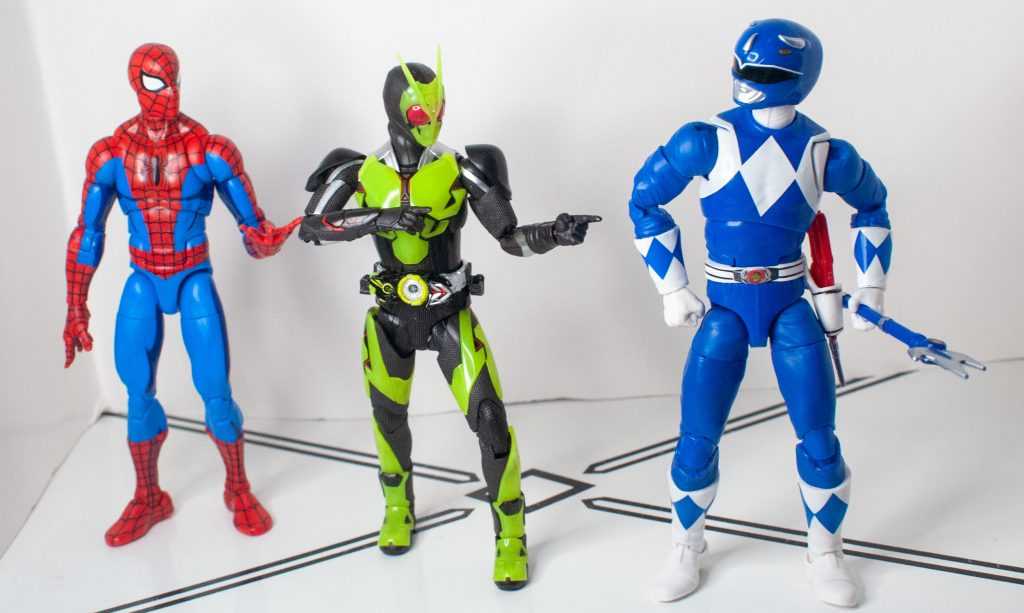
Friendship ended with Spider-Man, friendship begun with Super Sentai.
Zero-One’s primary colors are simple and dynamic, which is why I like the design: Black, with greenish-yellow highlights.
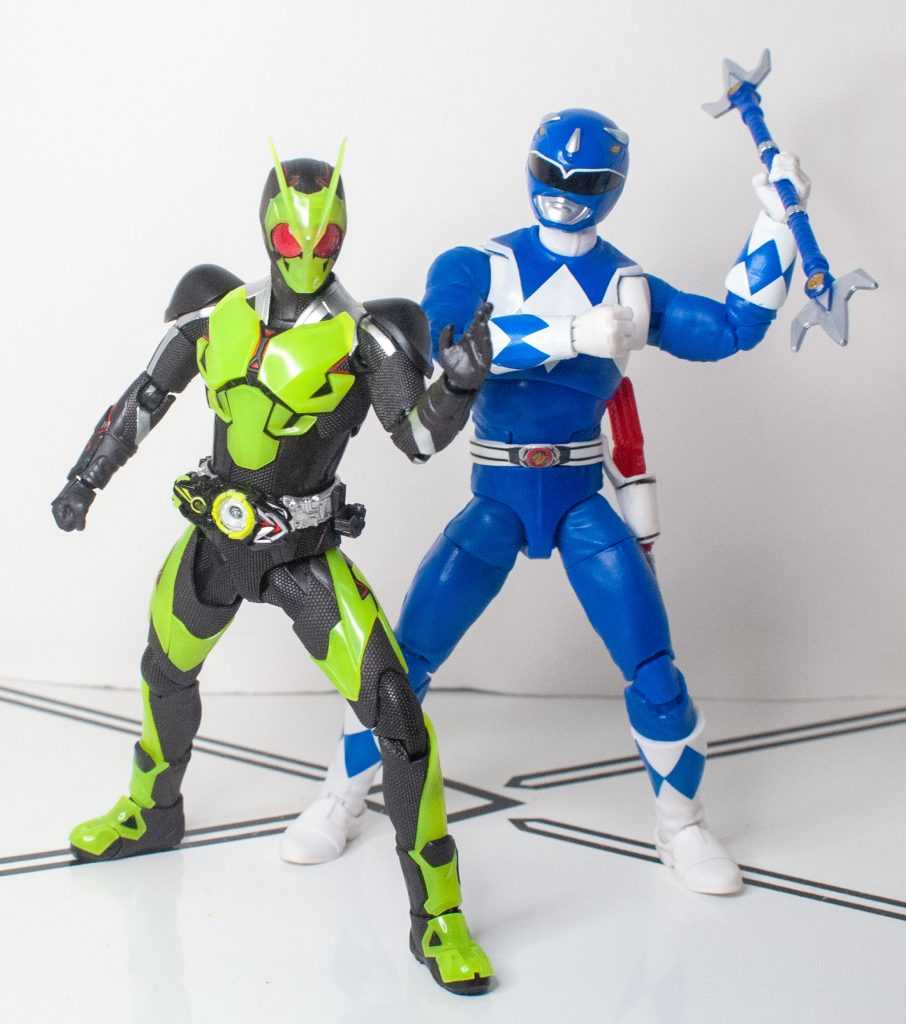
He is both the Green and the Yellow Ranger.
There’s more color on Aruto than just that, though. On his undersuit, he’s got silver detailing, including straps, and a bunch of miniscule red, techy details painted in.
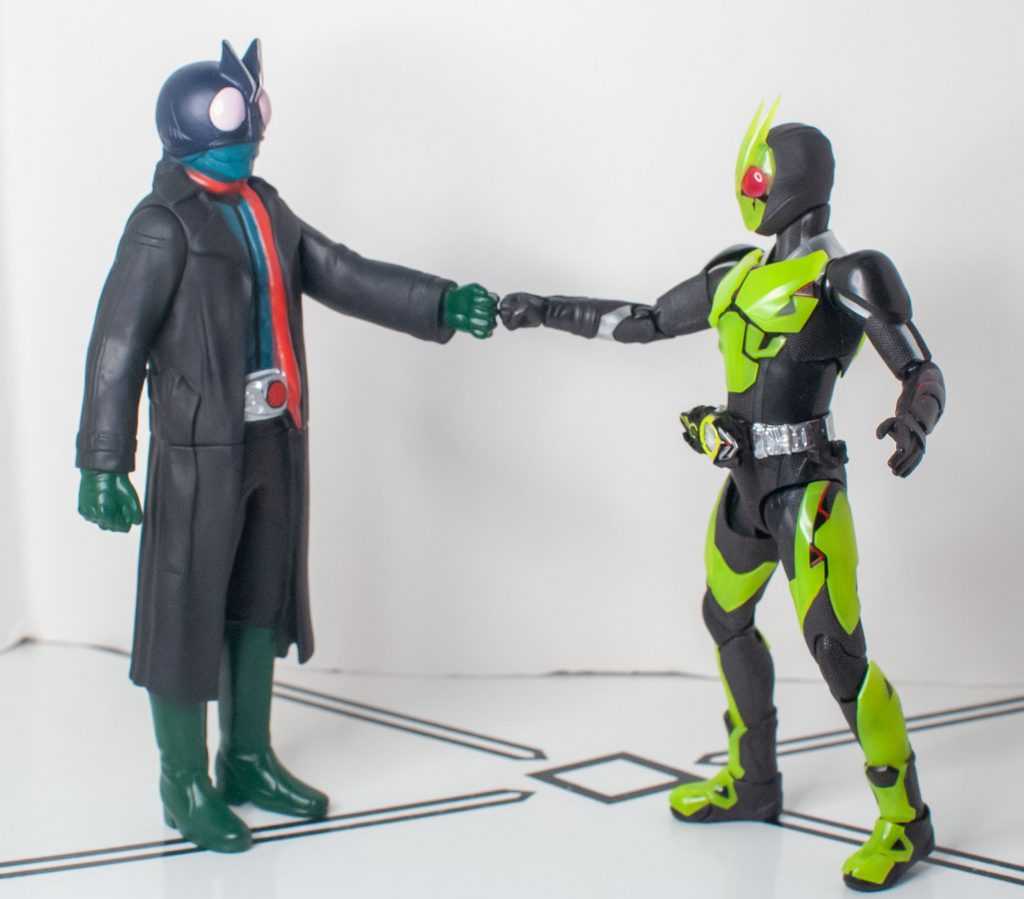
Dour meets colorful.
Meanwhile, the chunks of green armor that line his suit aren’t actually painted at all, they’re all separate pieces of green plastic, which is more impressive, since they were able to sprue it out, rather than approximate it with paint, and this includes his eyes, which are separate red pieces. Again, shout out to the Zero-One Driver at his waist, there’s tons of color on it, to replicate the physical prop, including that tiny “Rising Hopper” logo, and the only hits of green paint on him.

“Check out my muscles, they’re totally not just sculpted-on armor plates!”
As I mentioned in the introduction, this is a convention exclusive version of the figure, which means it has translucent parts. In this case, his greenish-yellow armor is rendered in clear plastic, instead of opaque, like on the real suit.

“Oh no, they saw right through me! And that’s a work of Aruto!”
It’s a variation I don’t mind, because, honestly, it looks good on him, and makes him almost look like he’s glowing with power. Plus, the fact that it’s just the green armor plates that are clear means this looks like it could still physically exist as a suit, and it helps that they’re not especially see-through, there’s just a little bit of translucency to them. Compare it to another character from the show that also got a clear exclusive, Kamen Rider Horobi, whose whole body was now cast in clear plastic.
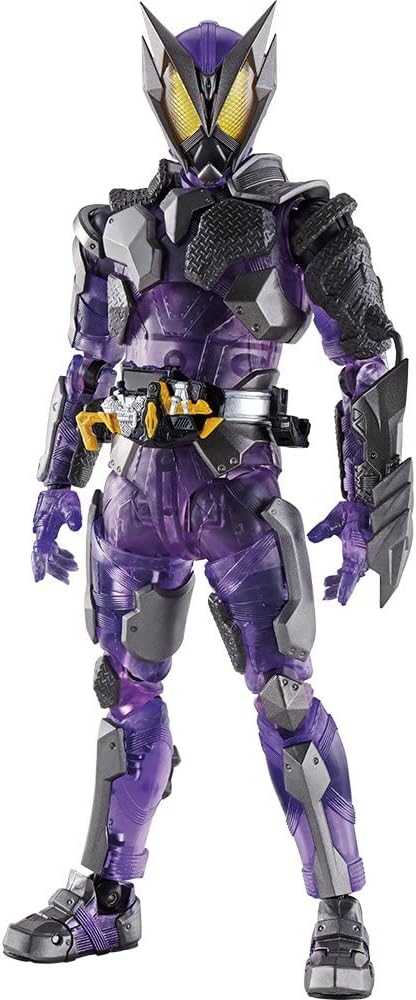
His joints all being clear plastic makes me nervous.
Build Quality
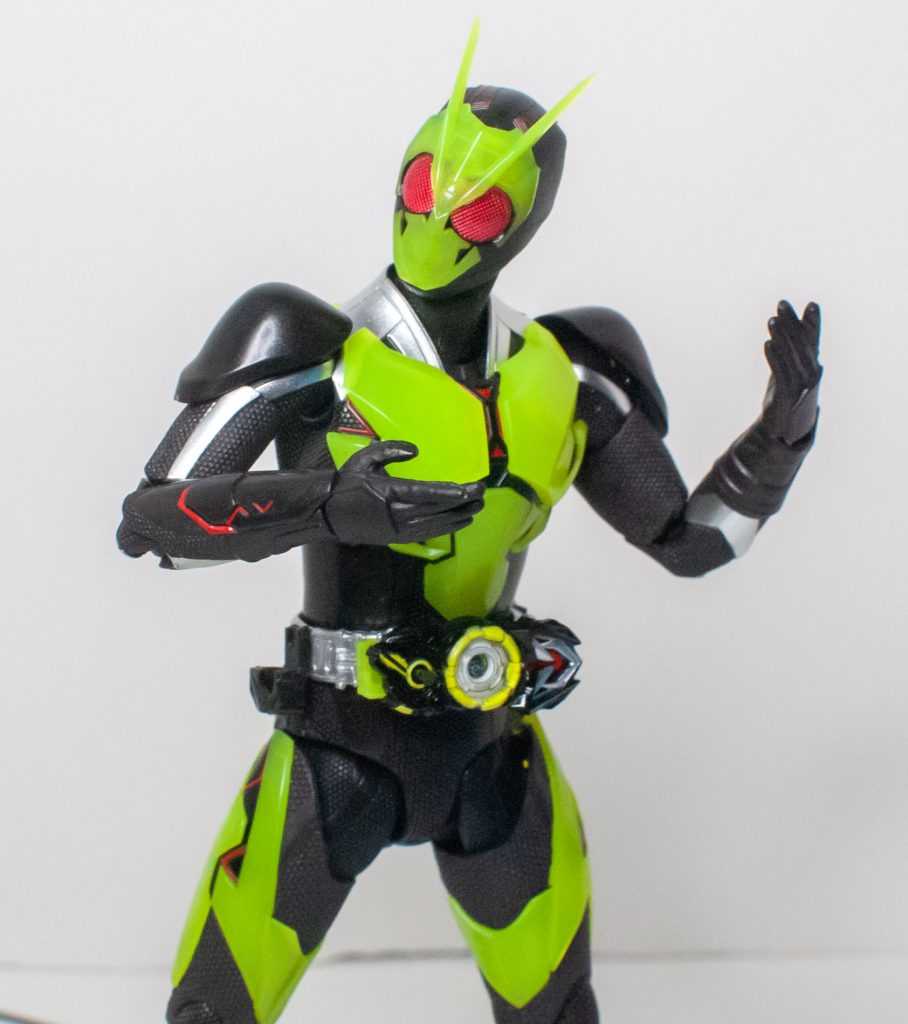
“Build? No, I’m Zero-One.”
The overall build quality of this figure is startlingly impressive to me, in the sense that it feels like a poseable toy you can toss around, and not a fragile collectible, like some high-end figures can feel like. It’s made out of rock-solid plastic, like I wish my Marvel Legends, and Splatoon and Zelda Figmas were made out of.
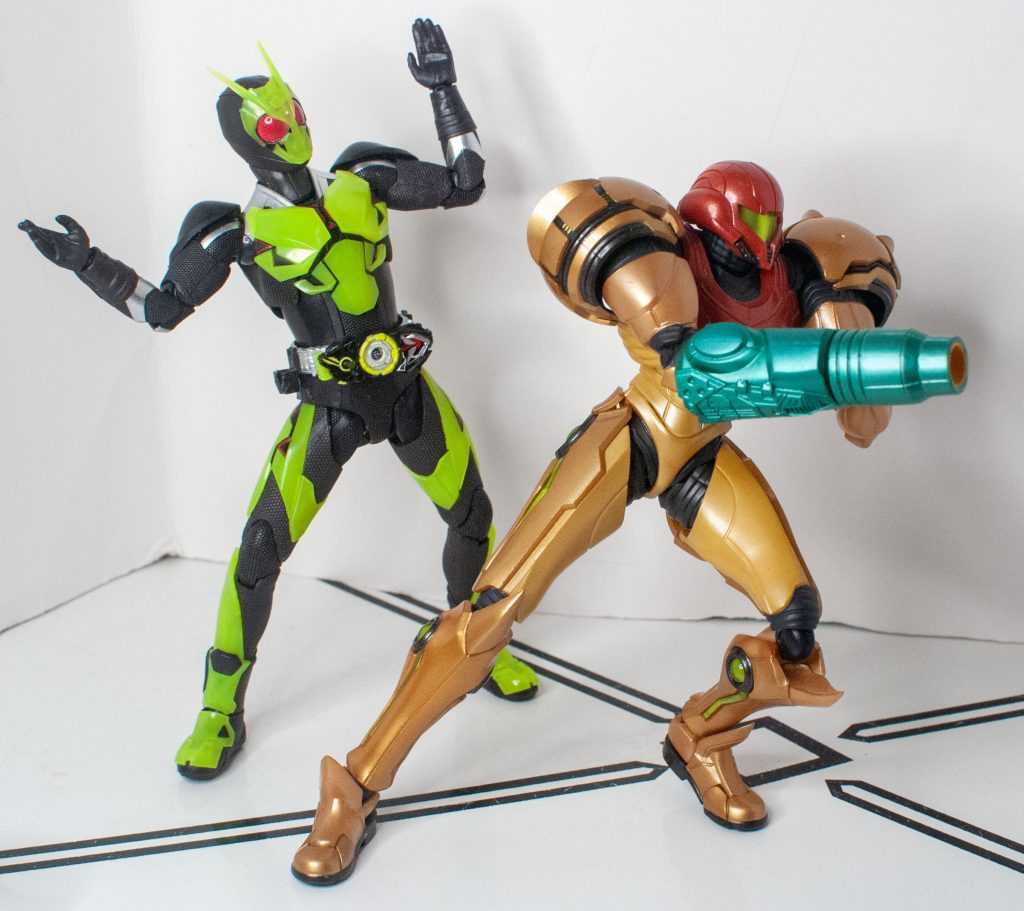
He’s even more solid-feeling than Samus, to be honest.
Even the translucent plastic on him doesn’t worry me, since it’s all used for surface details, and nothing remotely load-bearing. I’d say the only bit that gives me pause is his antenna, they’re oddly pointy and thin, outside of being translucent, so I could see them breaking if he took a fall.
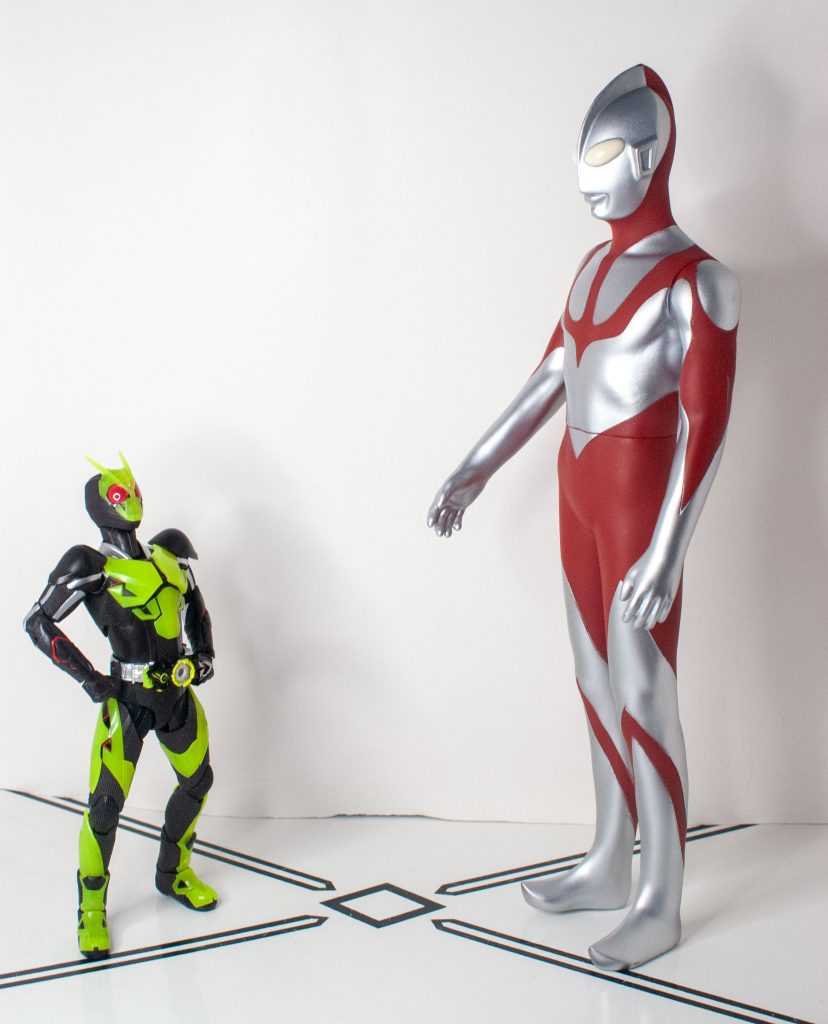
Meanwhile, this Ultraman Vinyl’s still the only thing that can fall off my desk and not worry me.
His belt is kind of loose around his waist, since it’s an entirely separate piece literally slapped overtop of him, but it oddly works, and makes it feel more like a physical suit. Who hasn’t had to adjust their belt?
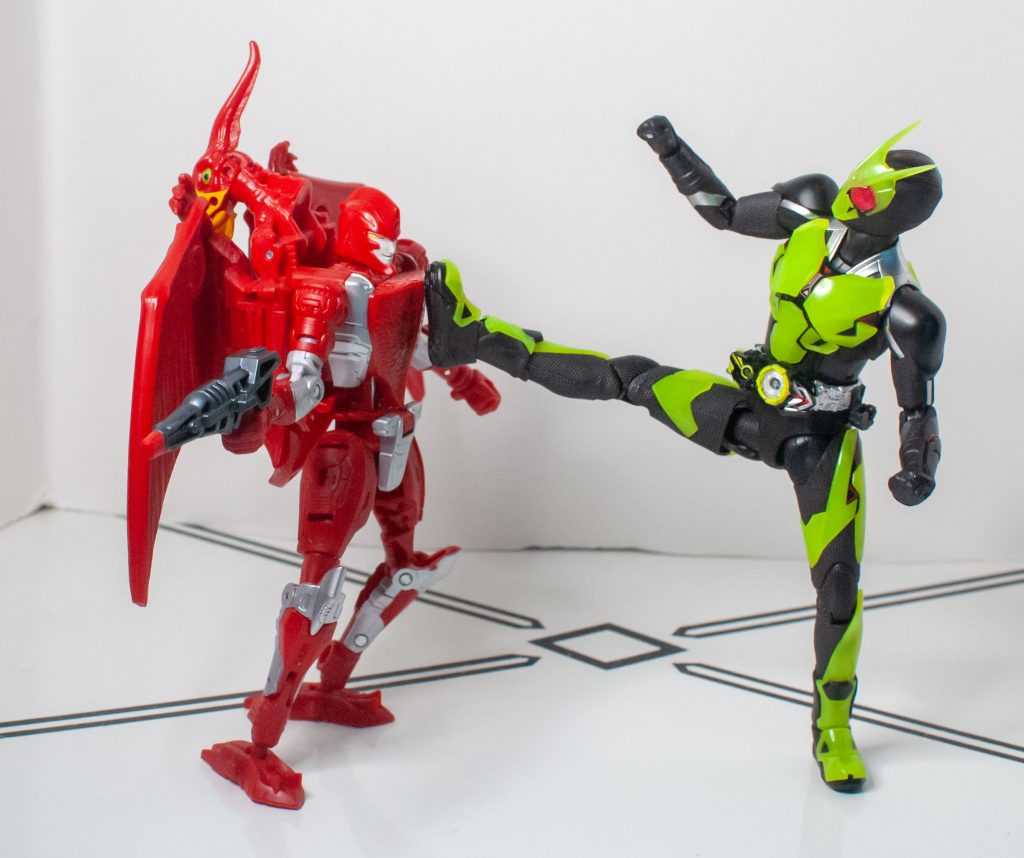
He’s stable enough to do this!
In terms of stability, while I kind of wish he came with a stand, he manages to be balanced enough to stay standing better than my Hasbro 6-inchers do.
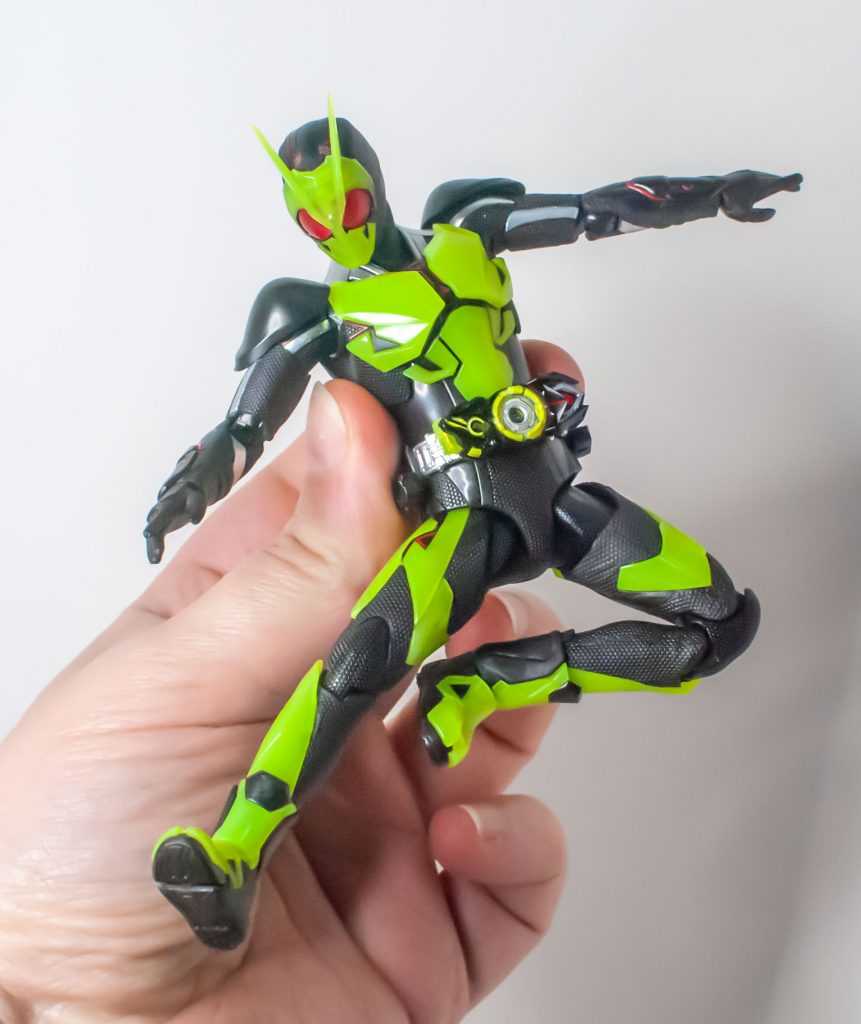
He still needed human assistance to pull off a Rider Kick, though.
Articulation:
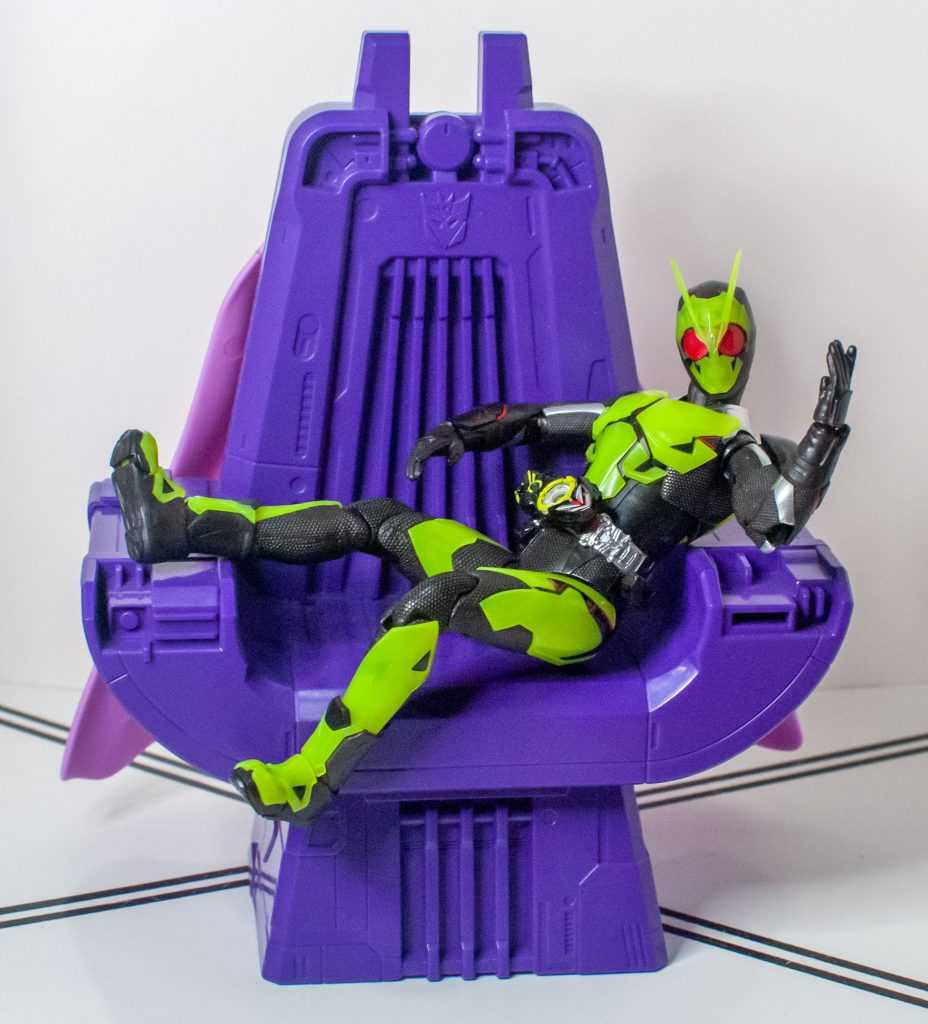
I have joints, and so I must chill.
Poseability is a selling point of Figuarts, and it’s definitely on display here, as Aruto comes with all the joints a human being has.
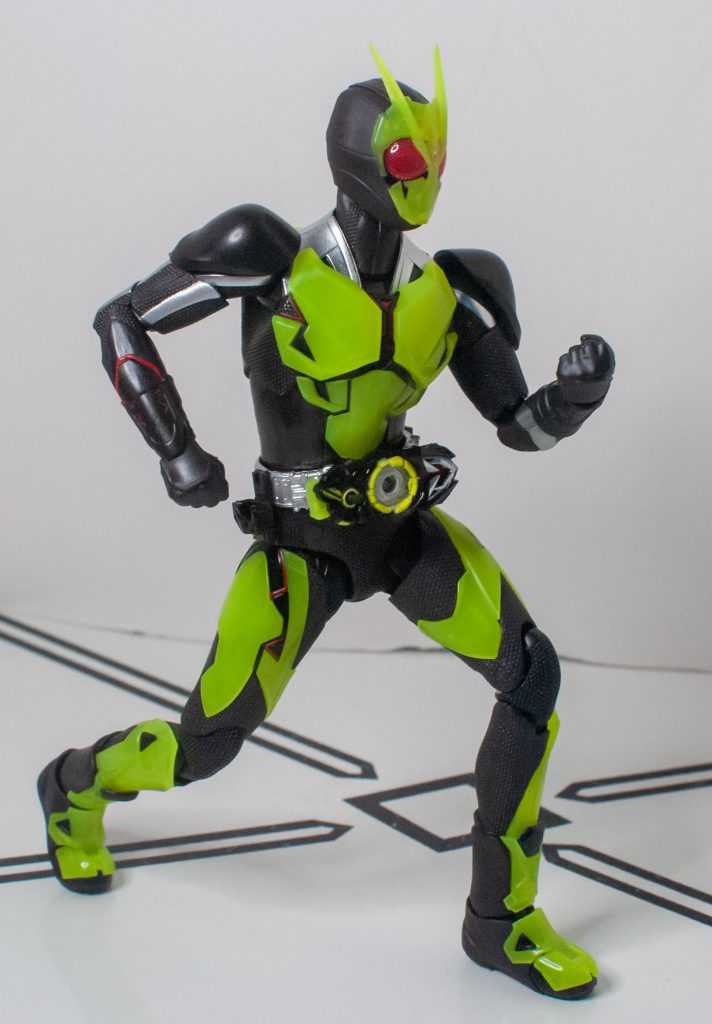
On his way to an open-mic comedy night.
Like I said in my Samus Aran review, it’s impossible to list them all, so I’ll just say: Yes, he has that one, and that one, and that one, and they’ve all got good range. He’s got all the same joints as my Marvel Legends Spider-Men, but his waist is actually where it’s supposed to be on a human, and is multi-jointed so that he has an ab crunch, and he also adds toe joints.
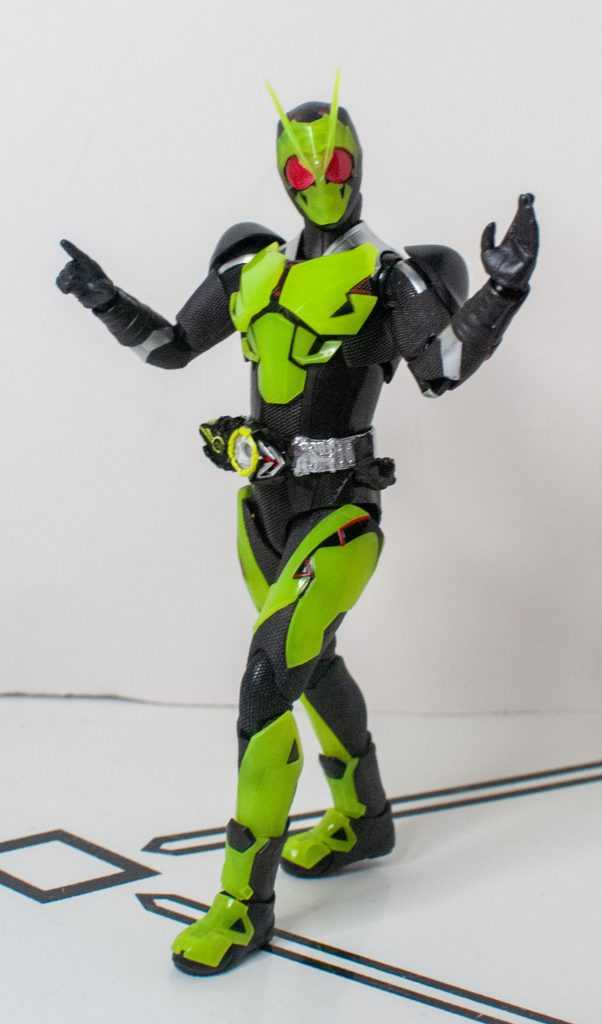
In the middle of his latest routine.
I’d say the only thing Samus has that he doesn’t is those convenient panels on her armor that gets it out of the way to increase range. Mr. Hiden here, meanwhile, has thigh-plates that bump against his waist when you try to do some more elaborate leg poses. Part of me wonders, though, if the physical suit didn’t just have the same restriction.

“How cute, a miniature HumaGear!” “I regret to inform you that your statement is slightly inaccurate.”
An important point of all of this articulation is the sense of character it gives off. Aruto Hiden is an animated, expressive character, full of exuberance and over-the top enthusiasm, and is prone to wild gestures (especially in-suit).

“A skeleton warrior? Looks like I’m boned!”
So the figure being able to imitate them is really important, and they nail it here. It’s not enough to just look cool, he has to look exaggeratedly enthusiastic, and he’s more than capable of it
Accessories
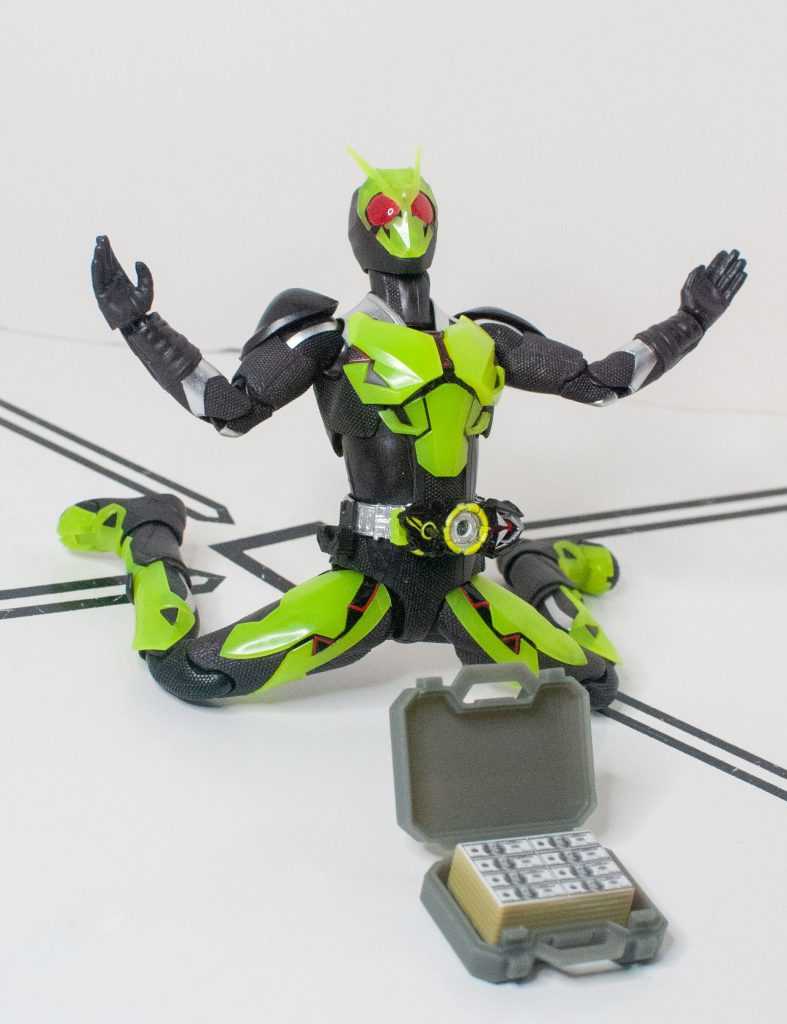
“I don’t need millions of dollars, I need a weapon!”
This is one area where they noticeably skimped out, I think. To be fair, I’ve talked about how “less is more” is often my preferred approach when it comes to the accessory loadout of high-end figures, and how I often just don’t ever use the big piles of parts that come with some of these (for example, Lightning Collection Billy’s sack of extra stuff). So let’s start with what’s here: Zero-One’s main accessories are just three sets of hands. He’s got closed fists…

“Zero-One is about to give them the One-Two!”
….splayed-open hands that can be karate chops or gestures…
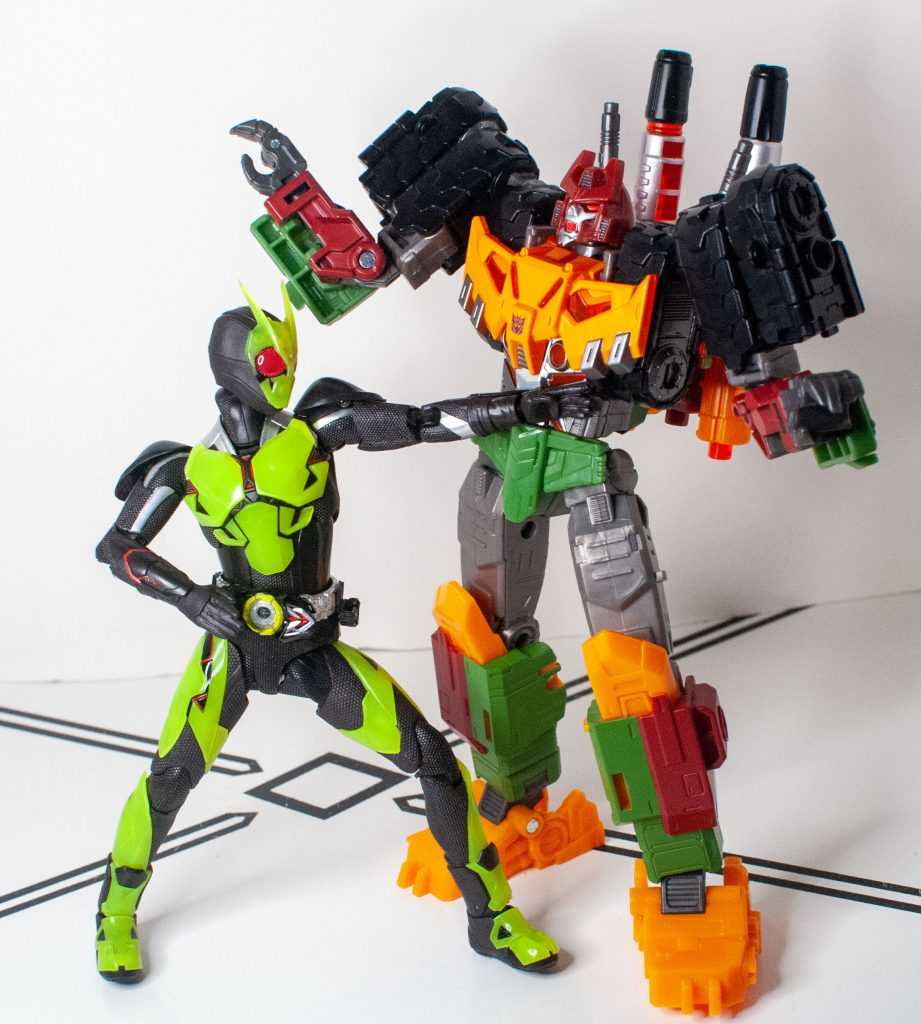
“This’ll rattle those bones!”
…and two dramatically-pointing hands, which are a great choice, since he did that a lot.
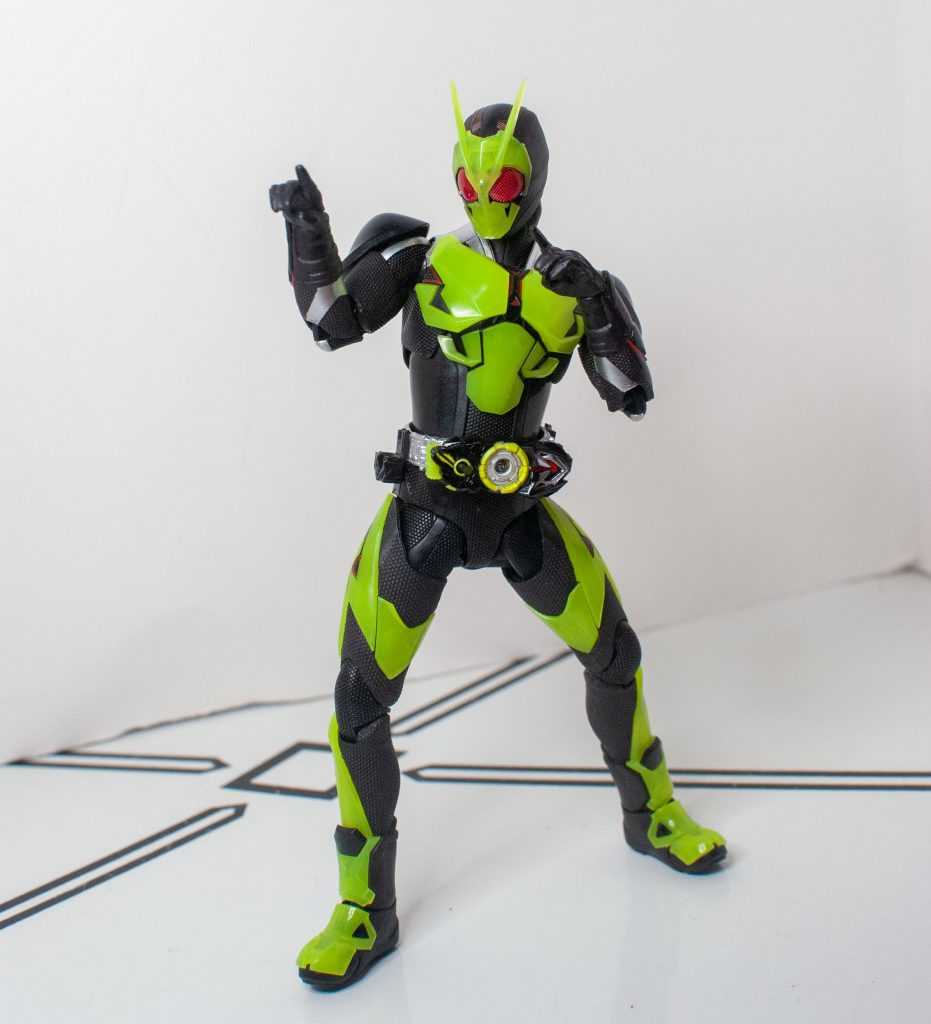
“YOUUUU!!”
What I feel like he’s missing is his signature weapon, though. He had a briefcase that could unfold into a big sword, called the Attache Calibur, and I find myself missing it here.
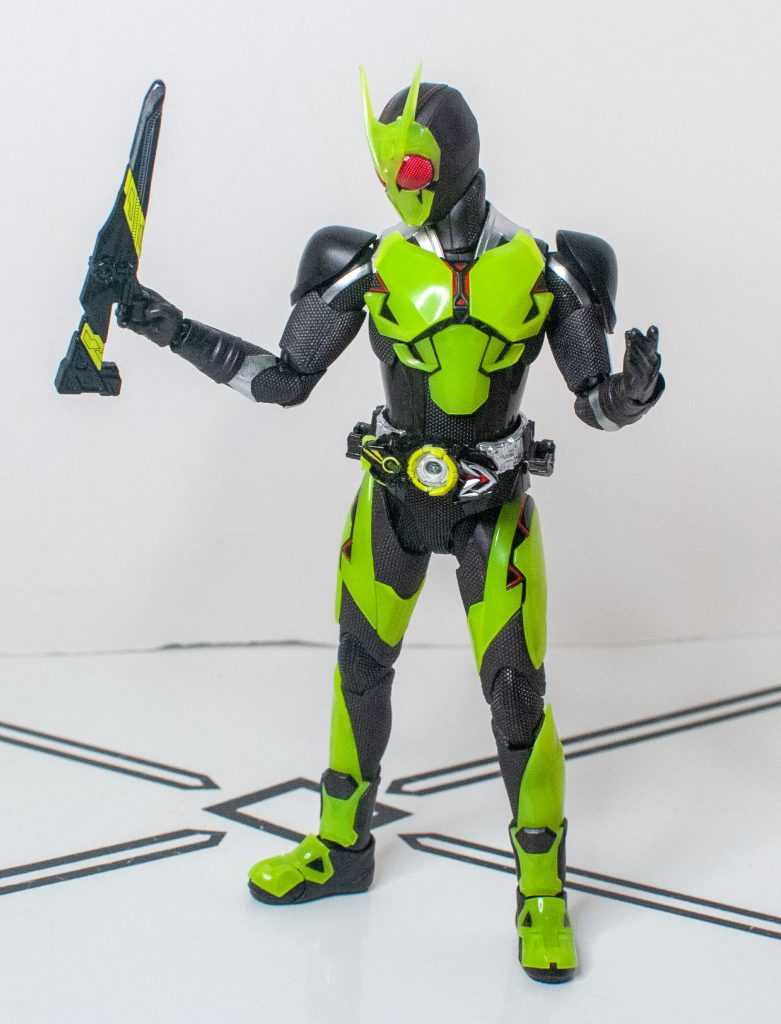
He can hold the one from the So-Do figurine, but it’s extremely undersized.
In a sneaky bit of upselling, it apparently comes included with another Figuart, of his hot-blooded ally, Kamen Rider Vulcan. Granted, Aruto didn’t always use his weapon, and would just throw hands plenty of the time, but it saw common enough use on the show that I wish he had it. That, and I wish some of his hands were meant for holding accessories, they’re all a bit ill-suited for it, even if he doesn’t come with any.
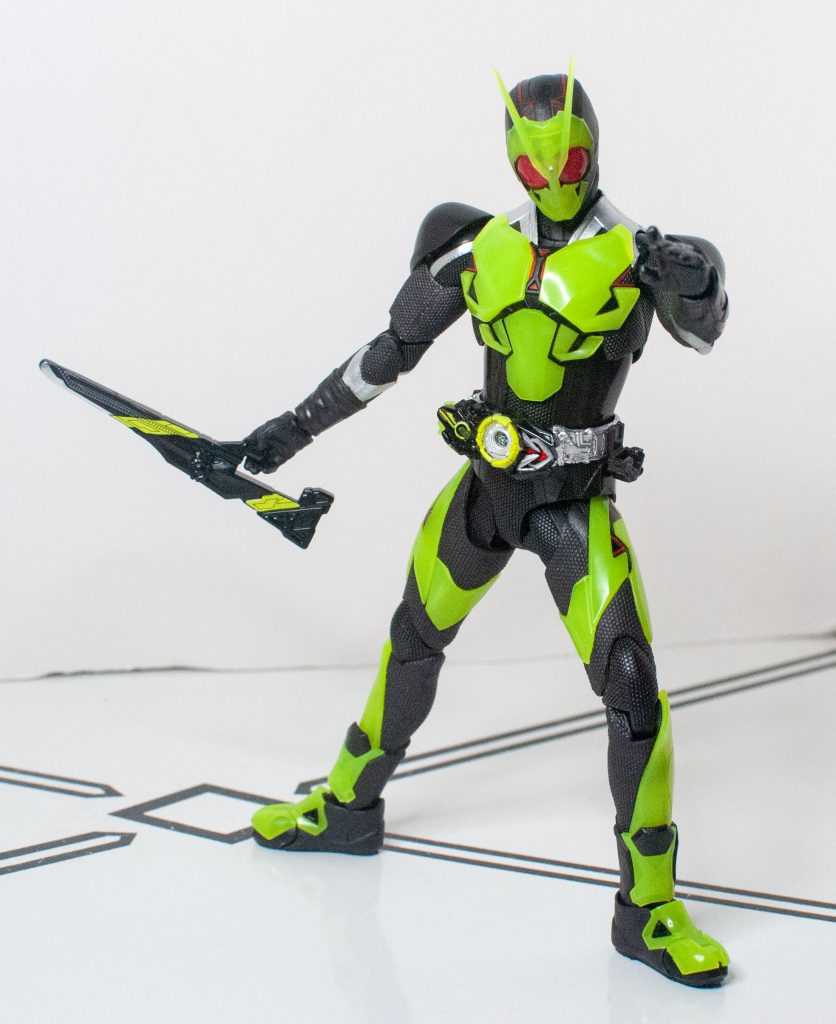
Trying to make it work.
There’s an additional accessory, though, which is a really cool feature: You can slide the Progrize Key out of the Zero-One Driver on his belt.
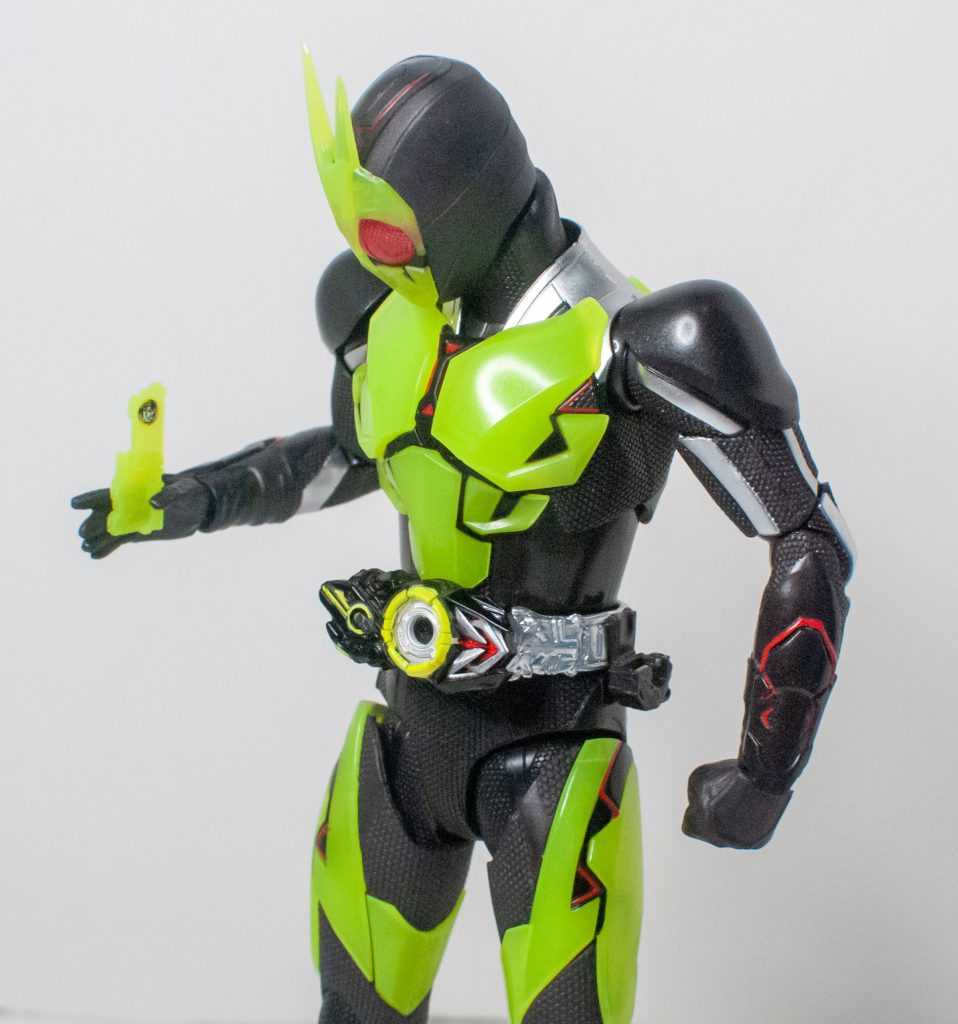
“How am I supposed to Transform if I’m already Transformed?”
This tiny, translucent green computer chip-looking object was how he’d activate the Driver, popping it in to materialize his armor, and using different keys was how he’d access alternate suits.

His transformation sequence involves a giant robot grasshopper jumping around.
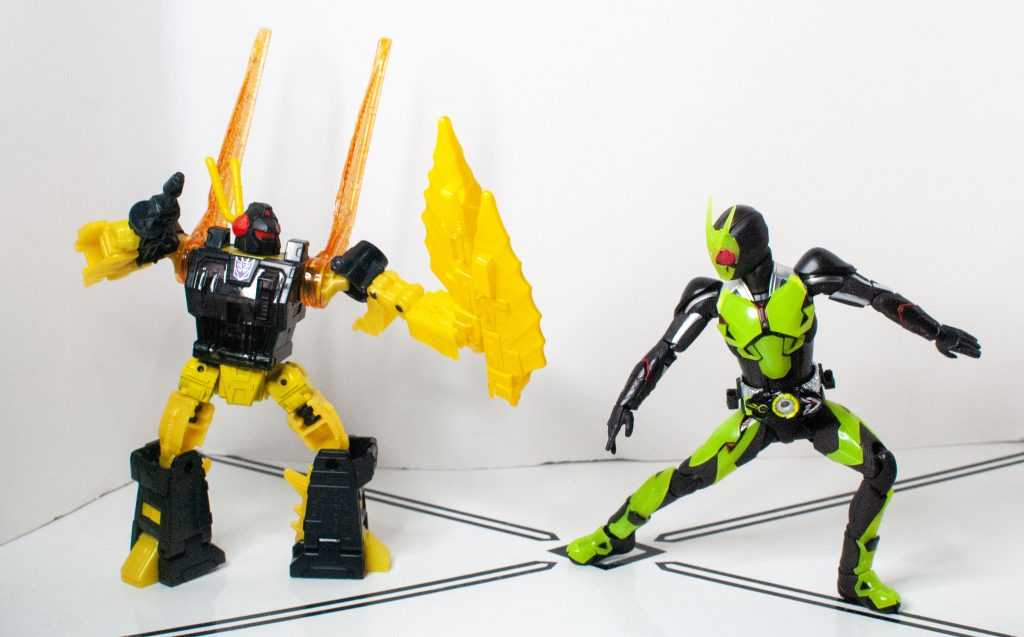
Fooled him!
It’s extremely detailed for its small size, and the tiny Rising Hopper tampograph is actually on the key itself, so sliding it into the driver makes it visible in the center, which is how the actual prop (and the toys they made of it) works. You can also kinda-sorta fit it in his hand, if you like.
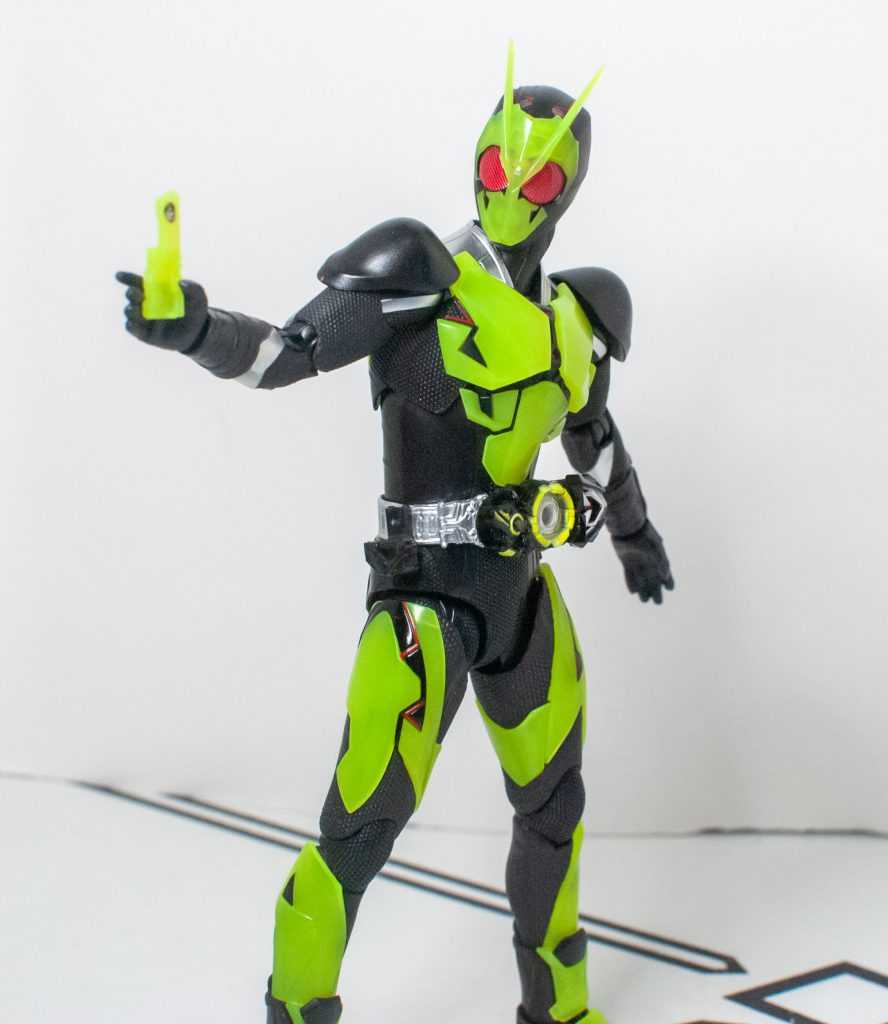
No joke here, this is just cool.
If I was going to be pedantic, I’d point out that it’s missing the rest of its coloration outside of the logo, but at this tiny scale, I’m just impressed it exists.
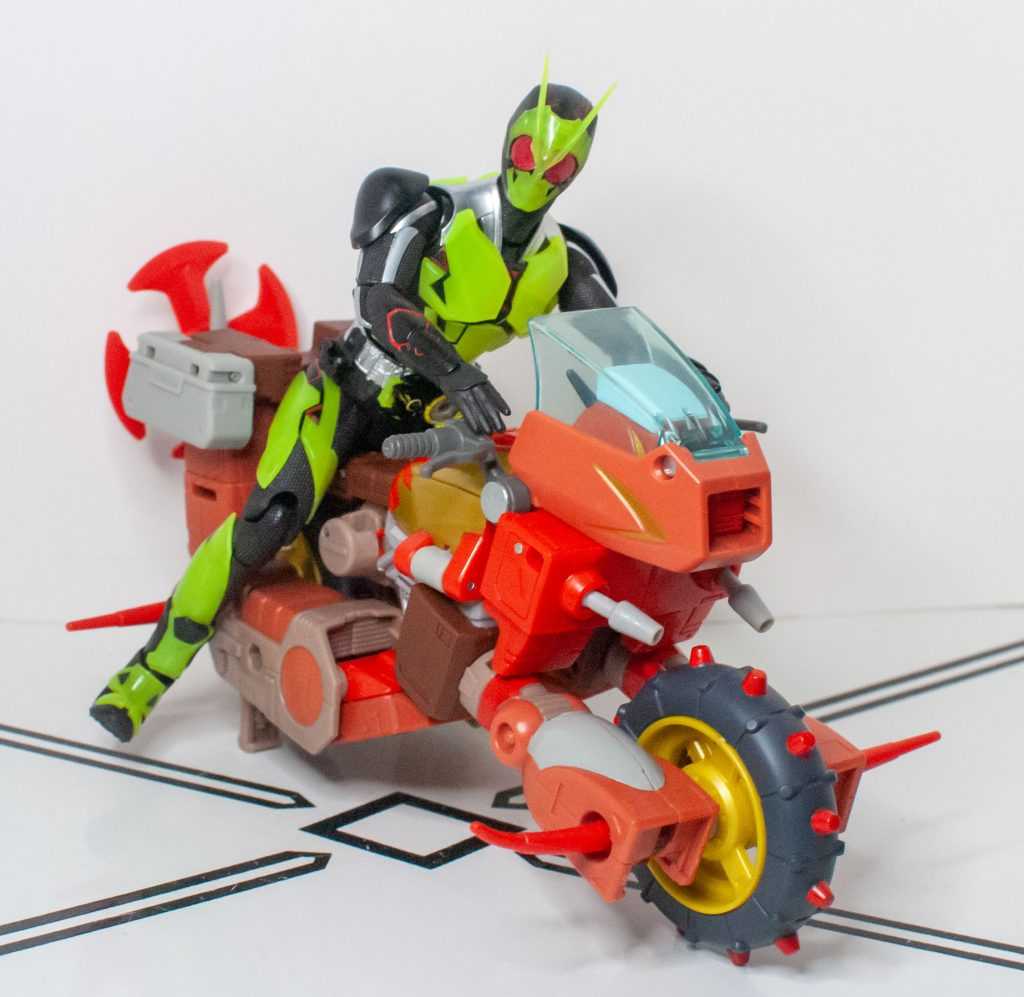
Apparently they also sell his bike, but Wreck-Gar here will have to do instead.
Overall
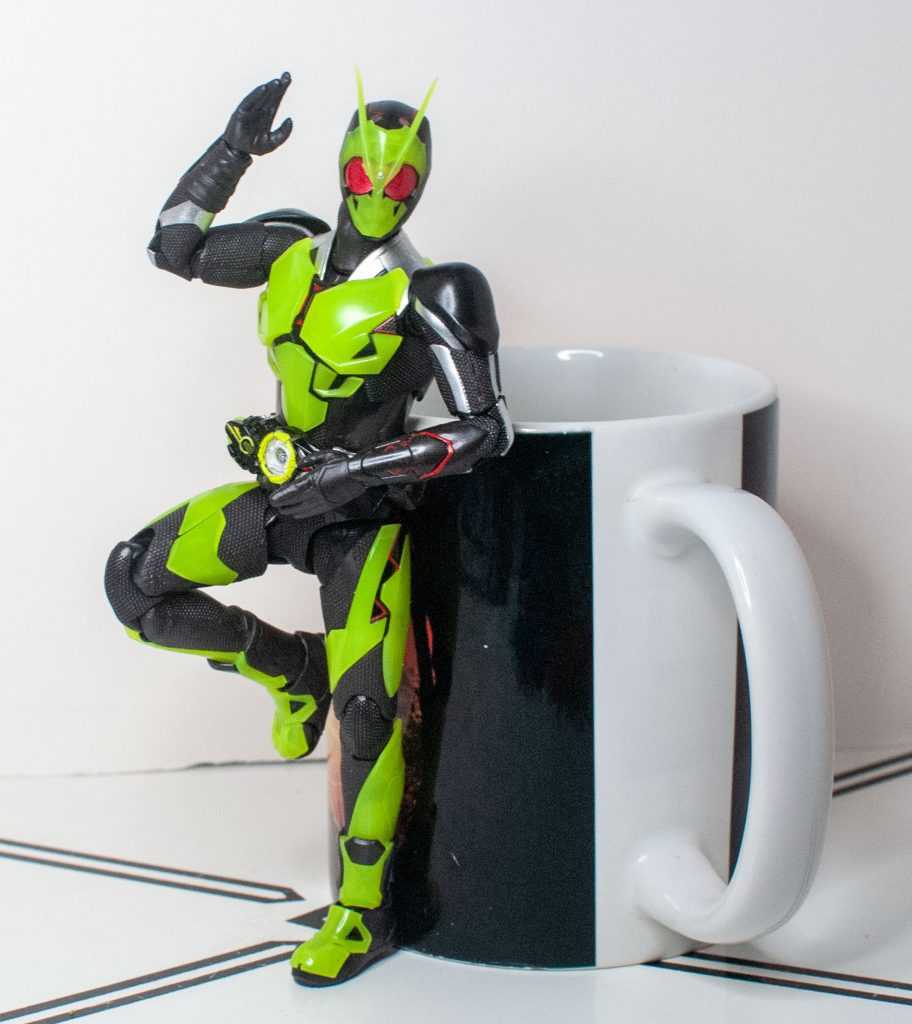
Real, strong, and my friend.
I love this guy. It’s a cool character, with a cool design, rendered in super-high-quality. He’s incredibly detailed and incredibly poseable, but most importantly, doesn’t feel too fiddly or fragile. You can keep him on your desk and pose him! This really is the good stuff. He’s high end, but the company that manufactured him didn’t forget he was a toy, too.
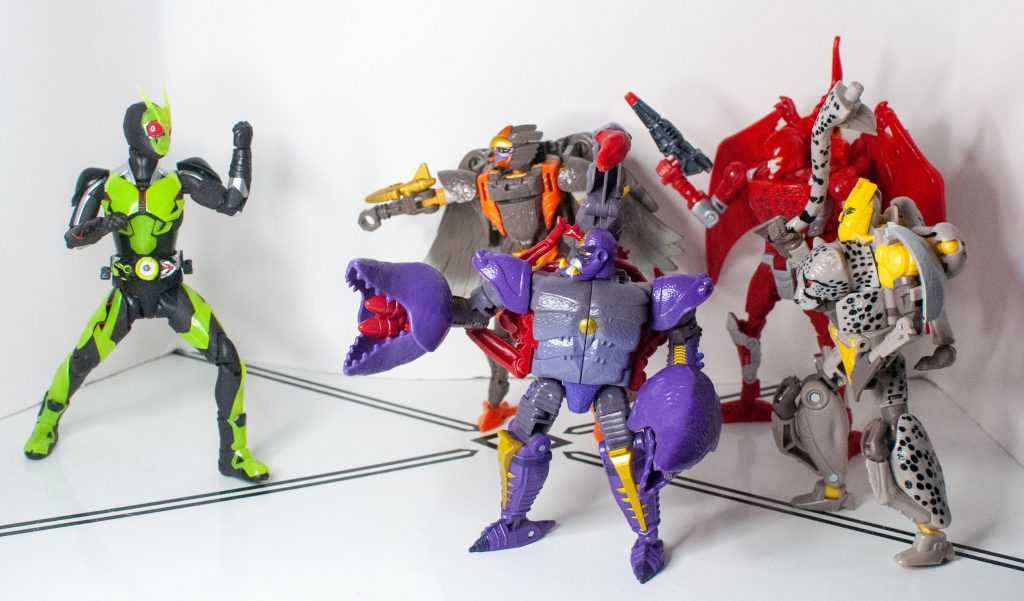
“Metsuboujinrai looks a little different…”
Literally my only complaint is he’s missing some potential accessories. This being a translucent variant is barely noticeable, and even makes him look a bit cooler, even. What’s cooler than that, though, is how this variant was made available to me for so cheap, and I’ve heard this guy, Horobi, and the clear Kamen Rider Saber that all got this treatment can also be found pretty cheaply, if you know where to look. Frankly, if you can get any SH Figuart at all for $60 Canadian (so that’s about $45 USD), do so. It’s incredibly, definitely worth it, for a perfect replica of the transforming hero of your choice. This guy’s for sure worth more than that.
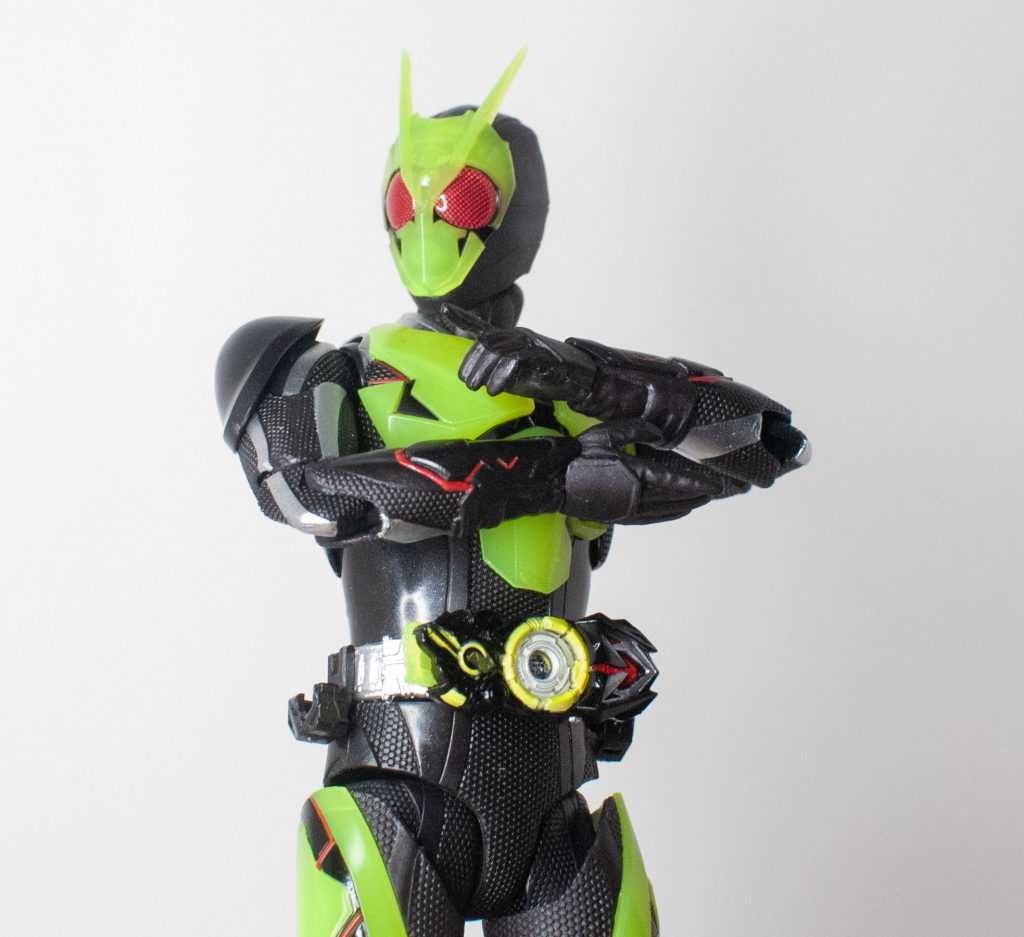
~You’re the only ooooone~
For over 100 Bot, Non-Bot, and Retro Bot Reviews, click here to view my archive.

